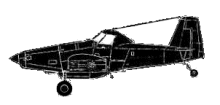
ASN Wikibase Occurrence # 188385
This information is added by users of ASN. Neither ASN nor the Flight Safety Foundation are responsible for the completeness or correctness of this information.
If you feel this information is incomplete or incorrect, you can submit corrected information.
| Date: | Monday 6 June 2016 |
| Time: | 15:30 |
| Type: |  Air Tractor AT-802 |
| Owner/operator: | Everts Air Fuel, Inc. |
| Registration: | N802CE |
| MSN: | 802-0467 |
| Year of manufacture: | 2012 |
| Total airframe hrs: | 874 hours |
| Engine model: | Pratt & Whitney Canada PT6A-67F |
| Fatalities: | Fatalities: 0 / Occupants: 1 |
| Aircraft damage: | Substantial |
| Category: | Accident |
| Location: | Fairbanks, AK -
 United States of America United States of America
|
| Phase: | En route |
| Nature: | Unknown |
| Departure airport: | Rampart, AK (RMP) |
| Fairbanks, AK (FAI) | |
| Investigating agency: | NTSB |
| Confidence Rating: |
The operator reported that the commercial pilot was returning to the home base after delivering a load of bulk fuel to a remote village. During climbout, the low fuel warning light started flickering but then extinguished. About 40 miles, or halfway, from the intended destination, the low fuel warning light illuminated again. About 20 miles from the intended destination, the engine lost all power. The pilot performed the engine-out emergency procedure and attempted to restart the engine to no avail. Subsequently, the pilot conducted a forced landing to a remote area, during which the airplane struck several large trees and steep, rocky terrain.
The operator reported that, during the recovery of the wreckage, both fuel tanks were found intact, and no usable fuel was found in either tank. Postaccident examination of the airframe and engine revealed no evidence of any preaccident mechanical malfunctions or failures that would have precluded normal operation.
The airplane was equipped with an electronic fuel flow indicator that had no fuel level sensing capabilities. The fuel remaining shown by the indicator relied solely on the pilot's input of fuel added; the fuel remaining shown on the indicator after the accident was 96.4 gallons. The measured fuel used since the last reset of the indicator was 77.4 gallons, which indicates that the fuel flow indicator was programmed with 173.8 gallons of fuel onboard at the last fueling or instrument reset. Given that the airplane ran out of fuel, the starting value of 173.8 gallons of fuel onboard was incorrect. Based on this evidence, it is likely that the pilot did not verify the initial fuel input level on the fuel quantity indicator, which resulted in an incorrect indication of the actual fuel remaining in the airplane and the subsequent fuel exhaustion and loss of all engine power.
Probable Cause: The pilot's inadequate preflight fuel planning, his reliance on the fuel flow indicator without verifying the initial fuel level input, and his improper decision to continue the flight with the low fuel light illuminated, which resulted in fuel exhaustion, the subsequent total loss of engine power, and a forced landing on steep, rocky terrain.
Accident investigation:
 |
|
Sources:
NTSB
Location
Revision history:
| Date/time | Contributor | Updates |
|---|---|---|
| 26-Jun-2016 13:41 | osiris | Added |
| 22-Apr-2020 17:00 | ASN Update Bot | Updated [Time, Operator, Other fatalities, Nature, Departure airport, Destination airport, Source, Damage, Narrative, Accident report, ] |
Corrections or additions? ... Edit this accident description
The Aviation Safety Network is an exclusive service provided by:


 ©2024 Flight Safety Foundation
©2024 Flight Safety Foundation